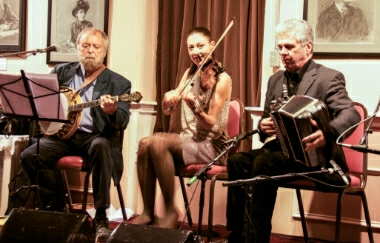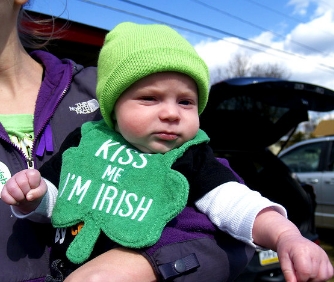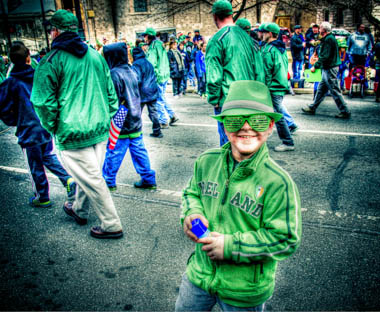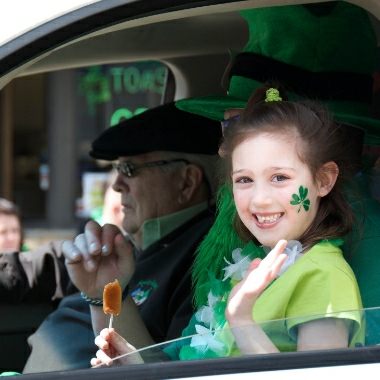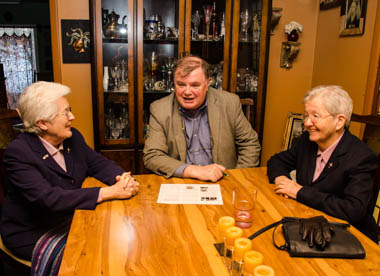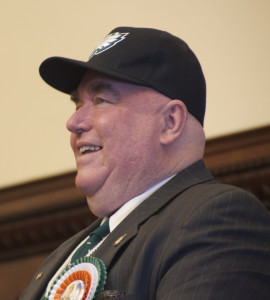 A lot of people in Philadelphia would say Jim Murray ought to be canonized on the strength of a single miracle: As general manager of the Philadelphia Eagles, he determinedly and methodically drove the team from its status as perennial cellar-dweller to its very first Super Bowl in 1980.
A lot of people in Philadelphia would say Jim Murray ought to be canonized on the strength of a single miracle: As general manager of the Philadelphia Eagles, he determinedly and methodically drove the team from its status as perennial cellar-dweller to its very first Super Bowl in 1980.
Sadly, the Birds lost to the Raiders, 27-10. Miracle workers can do only so much.
What many Philadelphia don’t know, perhaps, is that Jim Murray has devoted his entire adult life to miracles, not just the kind that occur within the confines of a gridiron. Those other miracles are far more enduring, and they have had a deep impact on thousands of people—maybe more.
On Sunday, Murray’s contributions to the betterment of the city and well beyond the city limits will be recognized as he marches up the Benjamin Franklin Parkway as another kind of GM—this year’s grand marshal of the Philadelphia St. Patrick’s Day parade.
To hear Murray tell it, his selection as grand marshal is just another shining example of the incredible good fortune that has followed him all his life. He is blessed with a genial, some might say “irresistible” personality, and you have to figure that helped. Murray could probably jolly the Israelis and the Palestinians into coming to the table, and afterward persuade them to play a pickup game of touch football in East Jerusalem. He has received every kind of award and honorary degree you can think of. He was inducted into the Philadelphia City All-Star Chapter of the Pennsylvania Sports Hall of Fame in 1992, and he received President Ronald Reagan’s Medal for Volunteers of America in 1987. For a man of so many achievements, he is curiously self-effacing.
Not bad for a guy from 812 Brooklyn Street in West Philly, where Murray spent his early years before moving with his family to Clifton Heights. There was nothing in Murray’s life that might have predicted the successful life he has had. But it wasn’t as if there was anything standing in his way, either, and early on Murray set out to make the most of his gifts. Murray, the son of Mary (nee) Kelly and Jim Murray, has always been possessed of an indomitable and optimistic spirit.
“We were poorer than poor, and richer than rich,” he says, “but West Philly was a wonderful place to grow up. Officer Gallagher was down at the corner. Everybody would turn you in if they saw you doing something wrong. Your street was your playground. We had no organized athletics, nothing like that, but I was always a sports fan. I don’t think you can put limits on prayer, God and good parents. Great teachers and mentors are a vital part of the equation. And it doesn’t hurt that you get lucky.”
When you hear Jim Murray speak, as he has had the opportunity to do several times since his choice as grand marshal, it is clear that he is a presence. Part of that particular aspect of his personality might have to do to with his build. He’s the first to joke about his belt size. Thursday night at the Doubletree Hotel in Center City, where he received his silken tricolor grand marshal’s sash, he worried aloud about whether it would fit. Every time he’s made a public appearance, he’s worn at least one hat. Last week at the CBS3 pre-parade party, he donned a gold yarmulke in tribute to his flawed, flamboyant, but nonetheless generous and beloved boss Leonard Tose. Yesterday, at a City Hall ceremony to declare March Irish Month, he wore a green Eagles cap. In neither case did it look like the headgear was a good fit for his head. His eyebrows are like furry little rain gutters. His cheeks are ruddy, and they rise like little helium balloons every time he smiles—which is often. He’s always good for a laugh—and often he’s the butt of his own jokes.
In short, Jim Murray is a big guy, but with a heart to match. He’s a hard guy to say no to.
And people have been saying yes to him for a long time.
But at least in one one case, someone said no early on. No matter who you are, you can’t escape hard knocks.
“I felt that I had a vocation, so in eighth grade, I went into the seminary, the Augustinian Academy on Long Island. In junior year, they thought a few of us had snuck out to see the Christmas show at Radio City. We didn’t actually go. We overcame the temptation. Long story short, we were expelled. That kind of thing is traumatic when you’re trying to decide. But once again, God has a sense of humor. I ended up getting thrown out and going to West Catholic. Being taught by the Christian Brothers was a great spirit.
After West, he attended Villanova. One day, he answered an ad for a student baseball team manager. He approached former Phillies first baseman and ‘Nova baseball coach Art Mahan. Murray admitted he wasn’t a baseball player, but he really wanted the job and was eager to learn. “Art Mahan changed my life,” says Murray. “When he died two years ago, he was 97 years old, the oldest living Phillies and Red Sox player. He gave me a lot of my personality training.”
It was Mahan’s advice that gave Murray his first break, in sports administration with the Tidewater Tides of the South Atlantic, or “Sally” League. After that, he served a tour in the Marine Corps Reserve, and then returned to baseball as assistant GM of the politically incorrectly named Atlanta Crackers. He went into the restaurant business for a time, but Mahan, who by then was Villanova’s athletic director, persuaded him to return to the university for a sports administration job.
“He called and said, ‘You have 24 hours to decide whether you want to come back here to be sports information director at Villanova.” Murray said yes. It didn’t take anywhere near 24 hours.
Murray loved the job, but a few years later, Mahan changed his life again.
“I was in the best job I ever had, but one day Artie said, ‘The Eagles are looking for an assistant PR director. You should go down and get interviewed.’”
Murray got the job. In time, through a lot of hard work and creative thinking, he moved up through the ranks to become the team’s general manager, and it was during those years that the team had its spectacular run.
One day, one of the Eagles’ players received the phone call no parent wants to receive. Murray remembers it well. It was a turning point for him, too.
“Fred Hill, who was a central casting tight end from Southern Cal, got a call from wife Fran at St. Christopher’s. His daughter Kim was diagnosed with leukemia.”
Leonard Tose being Leonard Tose, he rallied to the support of Hill and his family, and looked for bigger ways to help. He threw his support and his money into “Eagles Fly for Leukemia,” and he asked Murray to lead the effort.
“We had the first big event,” Murray recalls. “It was a fashion show. Then the boss called me over. He had many addictions, but No. 1 was his generosity.” Tose asked Murray to go go to St. Christopher’s to find out how else the Eagles might help. “I had no idea how that would be part of my life.”
Murray visited St. Christopher’s and talked to one of the top docs, who admitted the hospitals had many crying needs, but he knew someone who needed help even more. “He looked around, and he says, ‘We need everything, but there’s somebody with a greater need. He said, ‘Her name name is Dr. Audrey Evans, and she’s a world famous oncologist. She’s at Children’s Hospital at 18th and Bainbridge.’ So I went to see this lady, Dr. Evans. I said ‘My name is Jim Murray. I’m from the Philadelphia Eagles,’ and she says ‘What are they?’ I said we’re on TV every week,’ and she says, ‘I don’t have a TV.” I said, ‘We have money.’”
That got Dr. Evans’’ attention.
Tose wound up supporting Evans’ proposal to create special rooms for pediatric patients called “Life Lanes.”
But a later meeting with Dr. Evans led to something even bigger.
Murray met up with Evans at the Blue Line, a bar at the Spectrum, where he was going to present her with a check. “I said, now, what else do you need?’ and she said ‘It would be great if the parents of these children had someplace to stay.’ She said, ‘I want to buy a YMCA.’ I said, What you need is a house’ So she said, ‘Well, get us a house.’ Now I’m back to the rosaries.”
Murray had contacts in the MacDonald’s chain, and that was how he found out the restaurants were about to introduce the Shamrock Shake for St. Patrick’s Day. Murray asked for 25 cents off the sale of every Shamrock Shake to go toward the house. But then Murray got a call back from McDonald’s CEO Ed Renzi. ‘He said, if we give you all the money, can we call it Ronald McDonald House?’ I said, you can call it Hamburger House, anything you like.’”
That was in October 1974. Today there are 336 Ronald McDonald Houses in 35 countries.
Forty years later, Murray still can’t believe the project has come so far. And he still visits Ronald McDonald Houses just to see how the project still changes lives.
He recently visited the Philadelphia house with Dr. Evans.
“I never get used to it. There was a beautiful young girl from West Virginia, and her baby had a serious condition. I looked at Dr. Evans as she was looking at this young girl’s face, and I thought, it was exactly 40 years back at the Blue Line Bar that this started, and I thought about the kind of heart it took to bring these things together.”

